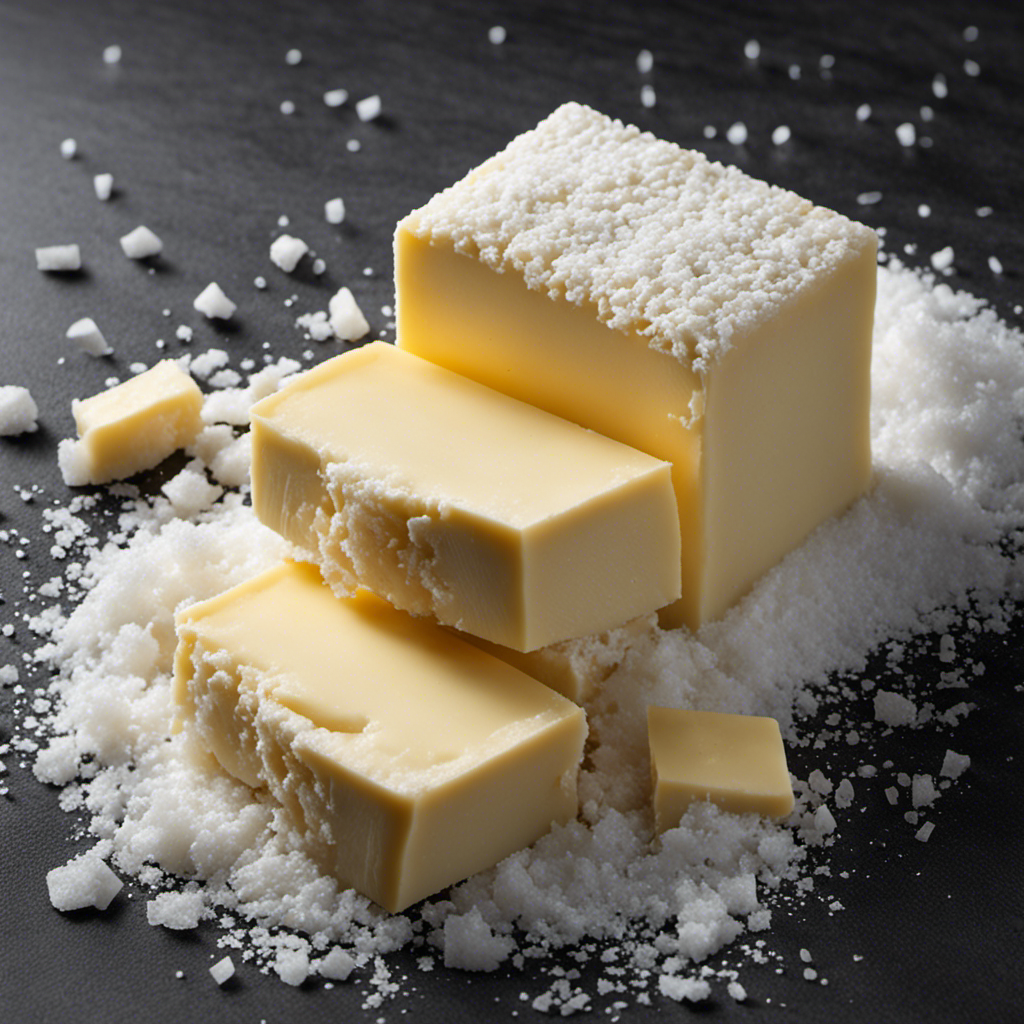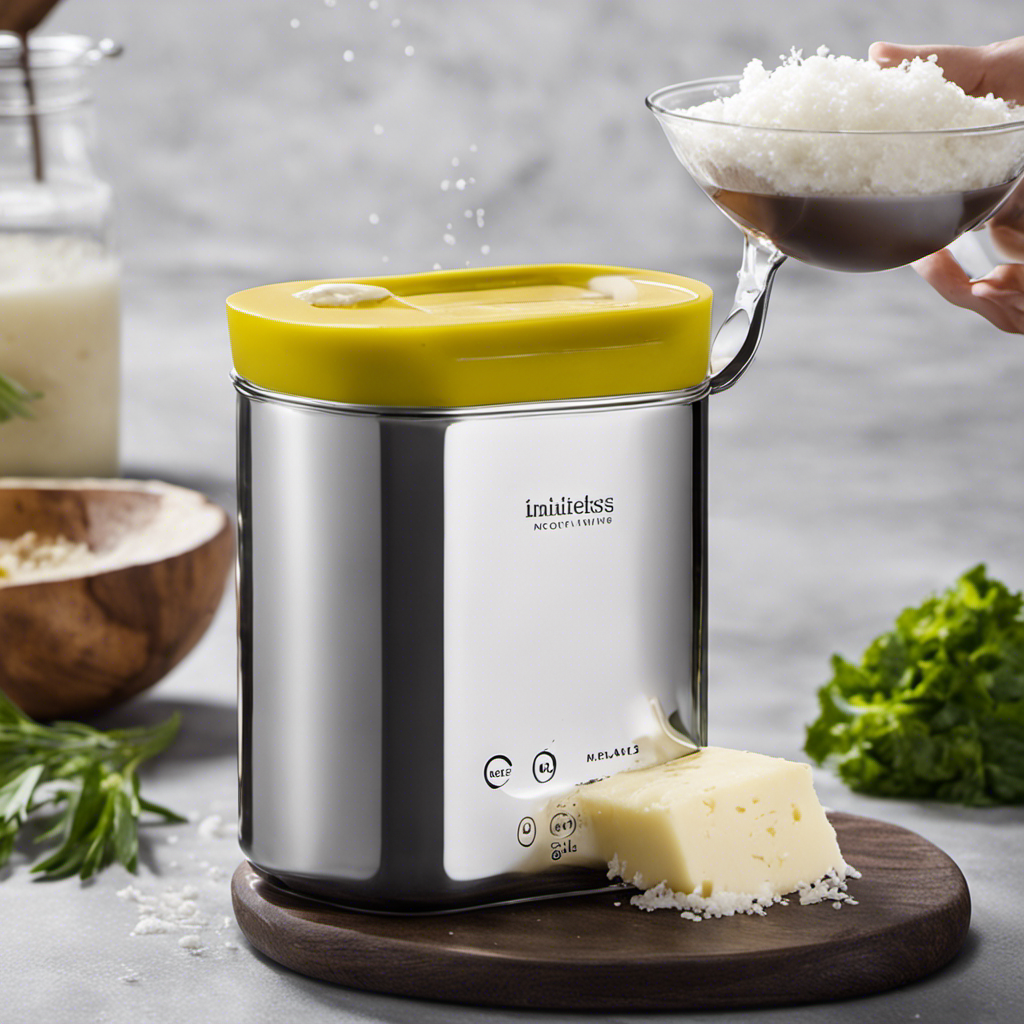As I have become more health-conscious, I have started to question the amount of sodium in the butter I enjoy spreading on a warm slice of bread.
In this article, we’ll delve into the sodium content of salted butter, exploring its impact on our health and comparing levels in different brands. Additionally, we’ll provide tips for reducing sodium intake without sacrificing our love for salted butter.
So, let’s butter up and uncover the truth about sodium in our favorite spread.
Key Takeaways
- One tablespoon of salted butter contains around 82 milligrams of sodium on average.
- Excessive sodium intake has been linked to health issues such as high blood pressure and increased risk of heart disease.
- Choosing unsalted butter allows for more control over sodium intake and can reduce overall sodium consumption.
- Sodium levels can vary among different brands of butter.
Understanding the Sodium Content in Salted Butter
You might be wondering how much sodium is in salted butter. Well, let me provide you with some information.
Salted butter does contain sodium, as the name suggests. On average, one tablespoon of salted butter contains around 82 milligrams of sodium. However, it’s important to note that the sodium content can vary slightly depending on the brand and manufacturing process.
When compared to other dairy products, salted butter generally has a higher sodium content. For instance, unsalted butter typically contains much less sodium, if any at all.
It’s also worth mentioning that excessive sodium intake has been linked to various health issues, including high blood pressure and an increased risk of heart disease. Therefore, it’s essential to monitor your sodium intake, even when consuming seemingly innocuous products like salted butter.
How Sodium Affects Your Health in Salted Butter
The amount of sodium in salted butter can have an impact on your health. Excessive sodium consumption can lead to various health issues, including high blood pressure, heart disease, and stroke. It is important to be mindful of our sodium intake, as the American Heart Association recommends limiting it to less than 2,300 milligrams per day.
Choosing unsalted butter over salted butter can provide several benefits for your health. By opting for unsalted butter, you have more control over your sodium intake and can reduce your overall sodium consumption. This can help lower your risk of developing health problems associated with excessive sodium intake. Additionally, unsalted butter allows you to enjoy the natural flavor of butter without the added salt, making it a healthier choice for those watching their sodium intake.
To better visualize the difference in sodium content between salted and unsalted butter, here is a comparison table:
| Sodium Content (per 100g) | |
|---|---|
| Salted | 800mg |
| Unsalted | 2mg |
As you can see, unsalted butter contains significantly less sodium compared to its salted counterpart. So, next time you reach for butter, consider choosing unsalted for the sake of your health.
Comparing Sodium Levels in Different Brands of Salted Butter
When comparing different brands of butter, it’s important to consider the varying levels of sodium. One specific aspect to consider is the sodium levels in organic salted butter.
While salted butter typically contains higher sodium levels compared to unsalted butter, the specific amount can vary depending on the brand. Some organic salted butters may have lower sodium levels compared to conventional salted butters.
It’s worth noting that sodium plays a significant role in the taste of salted butter. The right amount of sodium can enhance the flavor and add a savory note to dishes. However, excessive sodium can overpower the natural taste of butter and make it overly salty.
Therefore, it’s crucial to find a balance that suits your taste preferences when choosing a brand of salted butter.
Tips for Reducing Sodium Intake With Salted Butter
To reduce your sodium intake while using salted butter, opt for unsalted butter or low-sodium alternatives. Here are three tips to help you reduce your sodium intake with salted butter:
-
Choose unsalted butter: By choosing unsalted butter, you can eliminate the added sodium altogether. This is a simple and effective way to reduce your sodium intake while still enjoying the flavor and richness of butter.
-
Use low-sodium alternatives: If you prefer the taste of salted butter, look for low-sodium alternatives. These options typically contain less sodium than regular salted butter, allowing you to enjoy the flavor while minimizing your sodium intake.
-
Control your portion size: Be mindful of how much salted butter you use in your cooking or baking. By using smaller amounts, you can still enjoy the flavor while reducing your overall sodium intake.
Reducing sodium intake has numerous health benefits, including lower blood pressure and a reduced risk of heart disease. By making these simple adjustments, you can enjoy the taste of butter while prioritizing your health.
Sodium Alternatives for Salted Butter Lovers
If you’re a fan of salted butter but want to reduce your sodium intake, there are alternatives available.
High sodium consumption can lead to various health risks, such as high blood pressure and increased risk of heart disease.
Luckily, there are sodium-free butter options on the market that can still provide that rich, creamy taste you love. One such alternative is unsalted butter. It contains no added sodium, allowing you to control the amount of salt you add to your dishes.
Another option is using plant-based spreads, like avocado or nut butter, which are naturally low in sodium. These alternatives not only help reduce your sodium intake but also provide additional nutritional benefits, such as healthy fats and vitamins.
Frequently Asked Questions
Can I Use Unsalted Butter Instead of Salted Butter to Reduce My Sodium Intake?
Yes, you can use unsalted butter as an alternative to reduce sodium intake. Salted butter contains added salt, which increases sodium content. By using unsalted butter, you can control the amount of sodium in your dishes.
Is There a Recommended Daily Sodium Intake Limit for Adults?
There is a recommended daily sodium intake limit for adults, but it varies depending on factors like age and health conditions. It’s important to distinguish between natural and added sodium in foods to manage intake effectively.
How Does the Sodium Content in Salted Butter Compare to Other Dairy Products?
The sodium content in salted butter compared to other dairy products varies. It’s important to consider the effect of sodium intake from salted butter on overall health, as excessive sodium can contribute to high blood pressure.
Can Consuming Too Much Sodium From Salted Butter Lead to High Blood Pressure?
Consuming too much sodium from salted butter can lead to high blood pressure. However, it’s important to note that the relationship between sodium intake and heart health is complex and varies from person to person.
Are There Any Health Benefits of Consuming Sodium in Moderation With Salted Butter?
Consuming sodium in moderation with salted butter has no specific health benefits. However, excessive sodium intake can lead to health risks like high blood pressure. There are alternative options available for those looking to limit their sodium intake.
Conclusion
In conclusion, understanding the sodium content in salted butter is important for maintaining a healthy lifestyle.
While sodium can enhance the flavor of butter, it can also have negative effects on our health if consumed in excess.
Comparing sodium levels in different brands of salted butter can help us make informed choices.
To reduce sodium intake, we can opt for unsalted butter or try sodium alternatives.
Remember, too much sodium is like a tidal wave crashing down on our health, so let’s make smart choices and enjoy butter in moderation.










